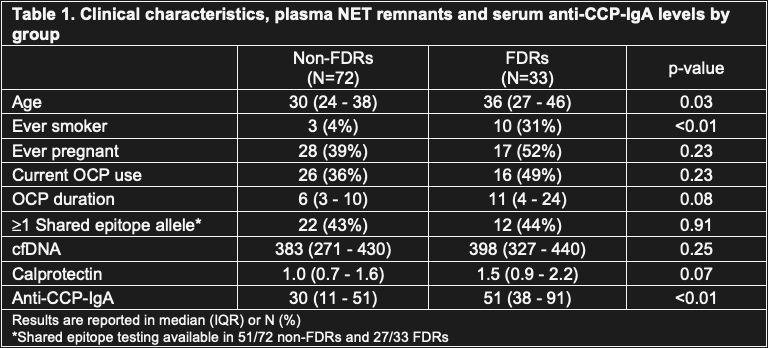Session Information
Date: Monday, November 13, 2023
Title: (1345–1364) Reproductive Issues in Rheumatic Disorders Poster II
Session Type: Poster Session B
Session Time: 9:00AM-11:00AM
Background/Purpose: Women develop RA 3 times more often than men, and several risk factors for RA are female specific. Prior studies demonstrate an association between oral contraceptive pill (OCP) use and a reduced risk of developing RA. However, the etiology of this protective effect remains unexplained. Anti-citrullinated protein antibodies (ACPA) develop prior to arthritis in RA, and their presence is associated with an increased risk of developing RA in the future. Exaggerated neutrophil extracellular trap (NET) formation has been implicated in RA pathogenesis, in part via externalization of citrullinated proteins targeted by ACPA. Moreover, neutrophils from pre-menopausal women are more prone to undergo NET formation (Blazkova 2017). Therefore, we investigated the relationship between OCPs, NETs and ACPA in pre-menopausal women without RA.
Methods: From the Denver site of the Studies of the Etiologies of RA cohort, we included all premenopausal women without RA and without pre-RA (i.e. serum anti-CCP-IgG positive) who had stored blood and were: 1) ‘current OCP’ users without prior use of other hormonal contraception, or 2) ‘never/prior OCP’ users without current/prior use of other hormonal contraception. Thirty-three had a first degree relative (FDR) with RA and 72 had no FDR with RA. Plasma was tested for NET remnants using immunofluorescence for cell free DNA (cfDNA, Quanti-iT PicoGreen dsDNA) and ELISA for calprotectin (Werfen). Serum was tested by ELISA for anti-CCP-IgA (research modification of CCP3.1, Werfen) as a measure of mucosal-based ACPA.
Results: Overall, FDRs were older, more likely smokers and had higher anti-CCP-IgA levels (Table 1). In women without an FDR with RA, cfDNA, calprotectin and anti-CCP-IgA levels were significantly lower in current OCP users compared to never/prior OCP users (Figure 1A-C). In adjusted analyses, cfDNA levels remained significantly inversely associated with current OCP use, while lower calprotectin maintained a trend toward an inverse association with current OCP use (Table 2). In FDRs, current OCP users had lower calprotectin levels but not lower cfDNA or lower anti-CCP-IgA levels (Figure 1D-F). The relationships between cfDNA, calprotectin, and OCP use in non-FDRs and FDRs was maintained in adjusted analyses (Table 2). In current OCP users, there was no correlation between cfDNA, calprotectin or anti-CCP-IgA level and duration of OCP use (p >0.05), although overall median OCP duration was 7 years.
Conclusion: We found lower levels of plasma NET remnants and anti-CCP-IgA levels in current OCP users who were healthy premenopausal women without an FDR with RA. Calprotectin was similarly lower in FDRs currently using OCPs, although cfDNA and anti-CCP-IgA levels in FDRs did not differ by OCP status. Differences between FDRs and non-FDRs did not appear related to age or smoking, based on adjusted analyses, and may instead be related to underlying genetic or environmental predisposition to increased NET formation. These findings support further studies to better understand whether modulation of NETs could explain the previously established relationship between OCP use and reduced RA risk.
« Back to ACR Convergence 2023
ACR Meeting Abstracts - https://acrabstracts.org/abstract/plasma-neutrophil-extracellular-trap-remnant-levels-are-lower-in-premenopausal-healthy-women-using-oral-contraceptive-pills/



